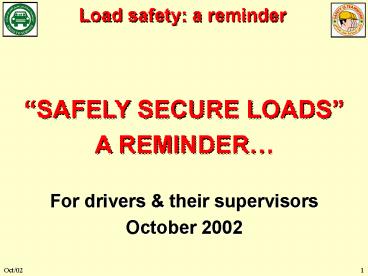Safely Secure Loads - PowerPoint PPT Presentation
1 / 13
Title: Safely Secure Loads
1
SAFELY SECURE LOADS A REMINDER For drivers
their supervisors October 2002
2
Did you learn from this fatality?
3
No you did not !! There are still badly secured
loads traveling on our roads today !!! See the
next few slides .
4
This is a 45 ton bulldozer that fell off a low
bed trailer because...
5
- Only two chains were usednot enough for a 45
ton dozer! - Steel tracks on steel low-bed low friction
factor! - Poor supervisionwrongly approved the loading
(staff not properly trained) - Driver- too fast round a sharp bend - braked
harshly
Should have used - 4 chains- wood deck
low-bed Driver should have- travelled at speed
safe for load and road conditions
6
ANOTHER EXAMPLE
Rock-breaker loose on the deck
Single chain
- a 28 ton backhoe retained with just ONE chain
- the rock-breaker is totally unrestrained
- Both would fall off in sharp or sudden turn
and could easily kill
someone......
7
Can you believe this??
- Wrong
- high bed trailer
- headboard split broken no protection to driver
(would be crushed if load moved forward) - chains slack and wrongly positioned
8
- Very slack chains
- No chocks
- Incorrect chain angles
- Trailer bed is too narrow
- Tyres overhang trailer an unstable load !
9
It is not only large loads that are not being
secured correctly !! It also applies to small
items.
This truck is loaded with oil drums 2 drums
stand loose! These can easily fall over, roll
around, get damaged and leak.
10
Here is a tall wooden crate restrained by a web
lashing which had broken and was knotted in two
places
Do not use lashings with knots they are NOT
strong. Throw them away! Destroy them! Do NOT use
them!
11
- Another totally unsecured load
- six pallets of flexible water pipe with no
lashings or any other load restraint used - a length of rope had been placed across the top
of the pallets, probably for decoration! - web lashing belts should have been used
- they were lucky this load did not fall off
12
- NOTE to Managers/Supervisors
- This presentation is a REMINDER of the importance
of load safety and good load securing. Prevent
further accidents due to poor load securing.
Follow the guidelines on the PDO-DtS
webhttp//www.pdo.co.om/hseforcontractors/dts/l
oads.htmUser Name pdohse01 Password
contractor01 - A detailed specification (SP-2001) is being
written and will be issued by end 2002. - In the meantime follow the British Department of
Transport Load Securing Code of Practice which
is available on the same website. - Another excellent Australian load securing guide
with more pictures and diagrams is also available
on the same website. - For further information CSM/15 tel 67-7956
13
Load Securing Guidelines Know them! Follow them!































